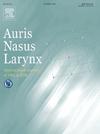甲状腺切除术后甲状腺功能减退的危险因素和发病时间
IF 1.5
4区 医学
Q2 OTORHINOLARYNGOLOGY
引用次数: 0
摘要
目的本研究旨在确定甲状腺肿瘤患者行甲状腺切除术后甲状腺功能减退的预后因素,并评估其发病时间。尽管术前甲状腺功能正常,但一些患者术后出现甲状腺功能减退,需要终身甲状腺激素替代治疗。识别风险因素和建立适当的随访指南对于优化患者管理至关重要。方法回顾性分析2016 - 2021年行甲状腺切除术的306例术前甲状腺功能正常(促甲状腺激素[TSH]: 0.61-4.23 mIU/L, fT4: 0.93-1.7 ng/dL)患者的资料。排除既往有甲状腺手术或激素治疗的患者。术后甲状腺功能评估至少2年。结果166例(54.2%)患者术后出现甲状腺功能减退,其中1个月内发现的占68.7%,1年内发现的占95.2%。多变量分析发现术前TSH水平(P = 1.60 × 10⁻¹5)和甲状腺过氧化物酶抗体和甲状腺球蛋白抗体双重阳性(P = 0.0431)是术后甲状腺功能减退的重要预测因素。术前区分甲状腺功能正常组和甲状腺功能低下组的最佳TSH临界值为1.82 mIU/L(受试者工作特征曲线下面积= 0.875)。确定了2.0 mIU/L的临床适用阈值,超过该阈值的患者中有90.1%发生甲状腺功能减退,29.7%需要甲状腺激素替代治疗。相比之下,术前TSH < 2.0 mIU/L的患者中只有3%需要激素治疗,提示该组有必要加强监测。结论术前TSH水平及抗tpo抗体和抗tg抗体阳性与术后甲状腺功能减退有关,提示其可作为术后甲状腺功能障碍的预后预测指标。术前TSH≥2.0 mIU/L的患者需要仔细随访,而TSH≥2.0 mIU/L的患者则不需要密切监测。鉴于95.2%的甲状腺功能减退病例发生在第一年内,甲状腺功能应在术后至少监测1年。此外,第一年出现甲状腺功能减退的患者应随访3年,以确保适当的管理。本文章由计算机程序翻译,如有差异,请以英文原文为准。
Risk factors and timing of postoperative hypothyroidism onset following hemithyroidectomy
Objective
This study aimed to identify prognostic factors for postoperative hypothyroidism and assess the timing of its onset in patients who underwent hemithyroidectomy for thyroid tumors. Despite normal preoperative thyroid function, some patients develop postoperative hypothyroidism, necessitating lifelong thyroid hormone replacement therapy. Identifying risk factors and establishing appropriate follow-up guidelines are essential for optimizing patient management.
Methods
A retrospective analysis was conducted on 306 patients with normal preoperative thyroid function (thyroid stimulating hormone [TSH]: 0.61–4.23 mIU/L, fT4: 0.93–1.7 ng/dL) who underwent hemithyroidectomy between 2016 and 2021. Patients with prior thyroid surgery or hormone therapy were excluded. Postoperative thyroid function was assessed for at least 2 years.
Results
Postoperative hypothyroidism occurred in 166 patients (54.2 %), with 68.7 % detected within 1 month and 95.2 % within 1 year. Multivariate analysis identified preoperative TSH levels (P = 1.60 × 10⁻¹⁵) and dual positivity for thyroid peroxidase antibody and thyroglobulin antibody (P = 0.0431) as significant predictors of postoperative hypothyroidism. The optimal preoperative TSH cutoff for distinguishing euthyroid and hypothyroid groups was 1.82 mIU/L (area under the receiver operating characteristic curve = 0.875). A clinically applicable threshold of 2.0 mIU/L was determined, with 90.1 % of patients above this level developing hypothyroidism, and 29.7 % requiring thyroid hormone replacement therapy. In contrast, only 3 % of patients with preoperative TSH <2.0 mIU/L required hormone therapy, suggesting the necessity of intensive monitoring in this group.
Conclusion
Preoperative TSH levels and the positivity of both anti-TPO and anti-Tg antibodies were associated with postoperative hypothyroidism, suggesting that they may serve as prognostic predictors for postoperative thyroid dysfunction. Patients with preoperative TSH ≥2.0 mIU/L require careful follow-up, whereas intensive monitoring is unnecessary for those with TSH <2.0 mIU/L. Given that 95.2 % of hypothyroidism cases occur within the first year, thyroid function should be monitored for at least 1 year postoperatively. Additionally, patients developing hypothyroidism within the first year should be followed for up to 3 years to ensure appropriate management.
求助全文
通过发布文献求助,成功后即可免费获取论文全文。
去求助
来源期刊

Auris Nasus Larynx
医学-耳鼻喉科学
CiteScore
3.40
自引率
5.90%
发文量
169
审稿时长
30 days
期刊介绍:
The international journal Auris Nasus Larynx provides the opportunity for rapid, carefully reviewed publications concerning the fundamental and clinical aspects of otorhinolaryngology and related fields. This includes otology, neurotology, bronchoesophagology, laryngology, rhinology, allergology, head and neck medicine and oncologic surgery, maxillofacial and plastic surgery, audiology, speech science.
Original papers, short communications and original case reports can be submitted. Reviews on recent developments are invited regularly and Letters to the Editor commenting on papers or any aspect of Auris Nasus Larynx are welcomed.
Founded in 1973 and previously published by the Society for Promotion of International Otorhinolaryngology, the journal is now the official English-language journal of the Oto-Rhino-Laryngological Society of Japan, Inc. The aim of its new international Editorial Board is to make Auris Nasus Larynx an international forum for high quality research and clinical sciences.
 求助内容:
求助内容: 应助结果提醒方式:
应助结果提醒方式:


